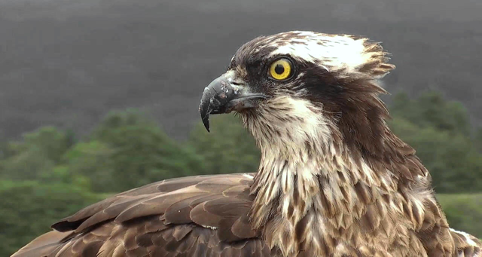Every year there is much media attention when the Glaslyn Ospreys return to the same nest site, it heralds the start of spring, although this year they have bought some snow with them.
You can monitor them in close up on the next via the live stream which is hosted on the Glaslyn Osprey website or here if that link isn’t working
Three Ospreys have returned to the Glaslyn Valley so far this year.
25th March saw Mrs G return for her 18th season.
29th March Aran join Mrs G for his 7th season.
31st March Aeron arrives a chick hatched in 2017 recognised by his Blue Z2 ring.

Mrs G was first discovered breeding at the Glaslyn nest in 2004. As she is not rung her age and previous history are not known. From her plumage and the time of year she first appeared it is thought that she was about 3 years old making her around 21 years old. To date, she has successfully raised 41 chicks, and has at least 100 grand-chicks and four great grand-chicks. Her first mate was Ochre 11 (1998) and together they raised 26 chicks. He failed to return in 2015, which was when she attracted her current mate, Aran. They have raised 15 chicks together so far.
Aran arrived at Glaslyn end of April 2015 again without a ring his previous history is unknown. From his plumage and his behaviour, it is thought he was 2 or 3 years old. His name comes from the mountain Yr Aran as this was the direction he was first spotted.
Ospreys return from North Africa around the end of March and usually in the second half of April the female lays two or three eggs at 1-3day intervals. The eggs are incubated for 37 days per egg with each egg hatching a few days apart, surprisingly there is little aggression and dominance shown by the older chick. Like most birds of prey, ospreys divide the nesting duties clearly between the pair. The female does most of the incubating, brooding and direct feeding of the young. She guards them throughout the nestling period, but will share the hunting at later stages when the chicks are larger. The male, on the other hand, is the major provider of fish for the female and young. After fledging at c. 53 days, both parents provide food for the young, which stay close to the nest for a further two months. The beginning of September sees them leave North Wales on their long migration journey to North Africa. Many juvenile birds die before they reach maturity at three years old. Those that reach breeding age can expect to live on average about eight years. The oldest known wild osprey was 32 years old.
The site is managed by Bywyd Gwyllt Glaslyn Wildlife a local community interest company who took over the stewardship from the RSPB in 2013. The success of the Glaslyn Ospreys and other wildlife projects are entirely reliant upon the kind donations of their visitors and supporters.
